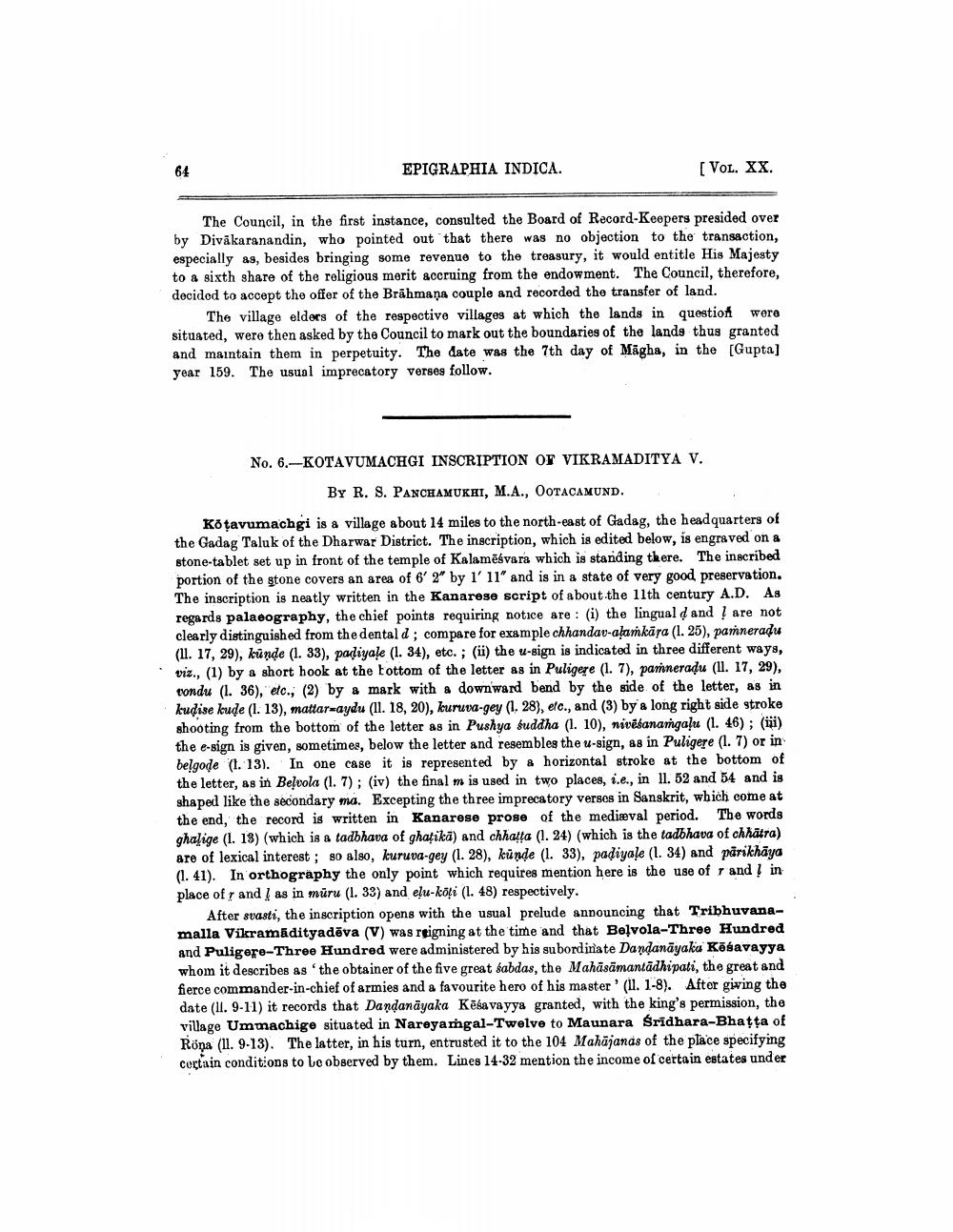________________
EPIGRAPHIA INDICA.
[Vol. XX.
The Council, in the first instance, consulted the Board of Record-Keepers presided over by Divākaranandin, who pointed out that there was no objection to the transaction, especially as, besides bringing some revenue to the treasury, it would entitle His Majesty to a sixth share of the religious merit accruing from the endowment. The Council, therefore, decided to accept the offer of the Brāhmaṇa couple and recorded the transfer of land.
The village elders of the respective villages at which the lands in question were situated, were then asked by the Council to mark out the boundaries of the lands thus granted and maintain them in perpetuity. The date was the 7th day of Mägha, in the [Gupta) year 159. The usual imprecatory verses follow.
No. 6.-KOTAVUMACHGI INSCRIPTION OF VIKRAMADITYA V.
BY R. S. PANCHAMUKHI, M.A., OOTACAMUND. Kotavumachgi is a village about 14 miles to the north-east of Gadag, the headquarters of the Gadag Taluk of the Dharwar District. The inscription, which is edited below, is engraved on a stone-tablet set up in front of the temple of Kalamēsvars which is standing there. The inscribed portion of the stone covers an area of 6' 2" by 1' 11' and is in a state of very good preservation. The inscription is neatly written in the Kanarese script of about the 11th century A.D. As regards palaeography, the chief points requiring notice are : (i) the lingual d and I are not clearly distinguished from the dentald; compare for example chhandav-alamkāra (1.25), paṁneradu (11. 17, 29), künde (1. 33), padiyale (1. 34), etc. ; (ü) the u-sign is indicated in three different ways, viz., (1) by a short hook at the bottom of the letter as in Puligere (1.7), pamneradu (11. 17, 29), condu (1. 36), etc., (2) by a mark with a downward bend by the side of the letter, as in kudise kude (1. 13), mattar-aydu (11. 18, 20), kuruva-gey (1.28), etc., and (3) by a long right side stroke shooting from the bottom of the letter as in Pushya buddha (1. 10), nivēšanangaļu (1. 46); (i) the e-sign is given, sometimes, below the letter and resembles the u-sign, as in Puligere (1. 7) or in belgode (1. 13). In one case it is represented by a horizontal stroke at the bottom of the letter, as in Belvola (1. 7); (iv) the final m is used in two places, i.e., in 11. 52 and 54 and is shaped like the secondary ma. Excepting the three imprecatory verses in Sanskrit, which come at the end, the record is written in Kanarese prose of the medieval period. The words ghalige (1. 13) (which is a tadbhava of ghafika) and chhała (1. 24) (which is the tadbhava of chhatra) are of lexical interest; so also, kuruva-gey (1.28), künde (. 33), padiyale (1. 34) and părikhāya (1. 41). In orthography the only point which requires mention here is the use of r and in place of r and I as in mūru (1. 33) and elu-köți (1. 48) respectively.
After svasti, the inscription opens with the usual prelude announcing that Tribhuvanamalla Vikramadityadēva (V) was reigning at the time and that Bolvola-Three Hundred and Puligere-Three Hundred were administered by his subordinate Dandanāyaku Kēšavayya whom it describes as the obtainer of the five great sabdas, the Mahāsāmantādhipati, the great and fierce commander-in-chief of armies and a favourite hero of his master' (11. 1-8). After giving the date (II. 9-11) it records that Dandanāyaka Kēšavayya granted, with the king's permission, the vilage Ummachige situated in Nareyamgal-Twelve to Maunara Sridhara-Bhatta of Röna (11. 9-13). The latter, in his turn, entrusted it to the 104 Mahājands of the place specifying certain conditions to be observed by them. Lines 14-32 mention the income of certain estates under




